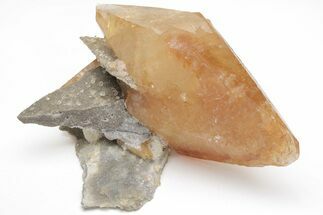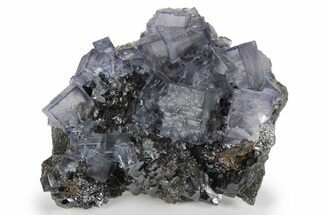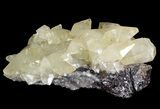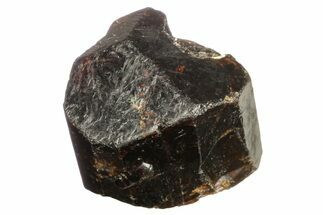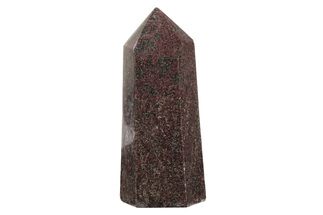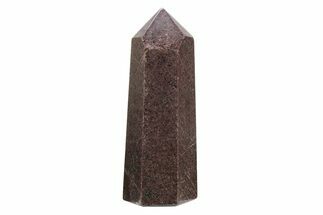This Specimen has been sold.
5.1" Calcite On Quartz & Sphalerite - Elmwood Mine
This is a beautiful, 5.1" wide specimen containing a sphalerite, quartz and calcite association, collected from the famous Elmwood mine in Tennessee. A sphalerite crystal cluster measuring 2.05" wide, can be found sitting atop a quartz encrusted matrix. On the opposite side of the specimen, an aggregation of gemmy, double twinned calcite crystals protrude from the rock matrix. This specimen comes with an acrylic display stand to assist with aesthetic presentation.
Shalerite ((Zn,Fe)S) is a mineral that is the chief ore of zinc while Galena is a primary ore for lead.
The Elmwood Mine is a zinc mine in Carthage, Tennessee that opened in 1969. It then closed for many years, only to be reopened in 2010. It has produced many world class specimens of fluorite, calcite, barite, and galena over the years. Specimens used to be plentiful as miners were allowed to recover specimens, but collecting is strictly prohibited by the new mine owners. They've gone to great lengths to prevent the mining of specimens, including blasting crystal pockets or filling them with slurry.
Shalerite ((Zn,Fe)S) is a mineral that is the chief ore of zinc while Galena is a primary ore for lead.
About Quartz
Quartz is the name given to silicon dioxide (SiO2) and is the second most abundant mineral in the Earth's crust. Quartz crystals generally grow in silica-rich environments--usually igneous rocks or hydrothermal environments like geothermal waters--at temperatures between 100°C and 450°C, and usually under very high pressure. In either case, crystals will precipitate as temperatures cool, just as ice gradually forms when water freezes. Quartz veins are formed when open fissures are filled with hot water during the closing stages of mountain formation: these veins can be hundreds of millions of years old.
Quartz is the name given to silicon dioxide (SiO2) and is the second most abundant mineral in the Earth's crust. Quartz crystals generally grow in silica-rich environments--usually igneous rocks or hydrothermal environments like geothermal waters--at temperatures between 100°C and 450°C, and usually under very high pressure. In either case, crystals will precipitate as temperatures cool, just as ice gradually forms when water freezes. Quartz veins are formed when open fissures are filled with hot water during the closing stages of mountain formation: these veins can be hundreds of millions of years old.
About Calcite Crystals
Calcite crystals are a form of calcium carbonate (CaCO₃) known for their diverse shapes, transparency, and vibrant range of colors. They typically form in rhombohedral, scalenohedral, or prismatic shapes, often with well-defined, sharp edges and glossy surfaces. Calcite crystals are often translucent or transparent, sometimes displaying a double refraction effect where objects viewed through the crystal appear doubled. They can appear in various colors—white, clear, yellow, pink, blue, green, and orange—depending on impurities or trace minerals.
A notable characteristic of calcite is its reaction with weak acids like vinegar, which causes it to effervesce, or fizz, as it releases carbon dioxide. This property makes calcite crystals a key tool in geological identification and studies. Calcite forms in many environments, from sedimentary rocks like limestone and marble to hydrothermal veins.
Calcite crystals are a form of calcium carbonate (CaCO₃) known for their diverse shapes, transparency, and vibrant range of colors. They typically form in rhombohedral, scalenohedral, or prismatic shapes, often with well-defined, sharp edges and glossy surfaces. Calcite crystals are often translucent or transparent, sometimes displaying a double refraction effect where objects viewed through the crystal appear doubled. They can appear in various colors—white, clear, yellow, pink, blue, green, and orange—depending on impurities or trace minerals.
A notable characteristic of calcite is its reaction with weak acids like vinegar, which causes it to effervesce, or fizz, as it releases carbon dioxide. This property makes calcite crystals a key tool in geological identification and studies. Calcite forms in many environments, from sedimentary rocks like limestone and marble to hydrothermal veins.
SPECIES
Sphalerite, Quartz & Calcite
LOCATION
Elmwood Mine, Carthage, Tennessee
SIZE
Specimen is 5.1 x 4.5"
CATEGORY
ITEM
#66313
 Reviews
Reviews
